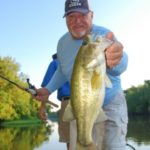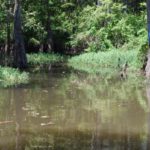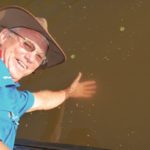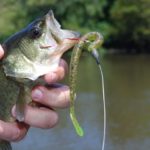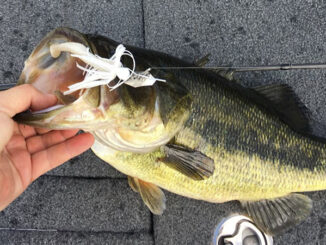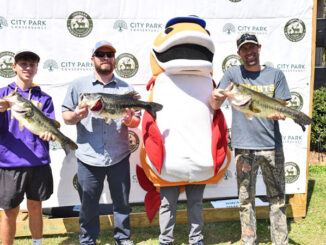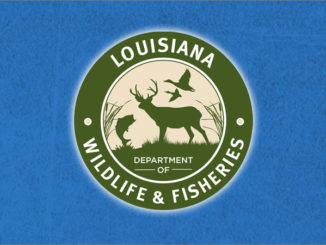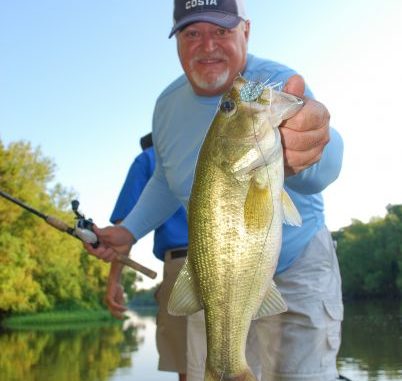
Falling water levels in the Atchafalaya Basin signal to anglers in the know that bass are ganged up and ready to feed — if you know where to look. Learn the keys to success from these Basin specialists.
“The drop is what everybody waits for,” the big dude said. “The fish have been swimming around in trees for months, and the falling water pulls them out into the canals and bayous.”
The big dude was Gene Hoover, a dedicated bass tournament competitor. With him was Kevin “Chef KD” Diez, a friend of 30 years who had introduced us.
We were in the Atchafalaya Basin, arguably the greatest and at the same time the most-frustrating (and massive) fishing hole in Louisiana.
Earlier in the day, Hoover and Diez launched Hoover’s boat at Doiron’s Landing in Stephensville.
“I like to launch there,” Hoover grunted, “because most of the major bass tournaments are held from this landing.
“Launching from the same landing allows you to plot your GPS routes from one place. The landing also provides access to almost all points I like to fish.”
The general strategy for the day was that, on a strong drop, you don’t want to be fishing in the interior of the Basin. When the water is sucking out, it is best to focus on the Intracoastal Waterway that hugs the Basin’s eastern guide levee and the Atchafalaya River.
That’s because these are the major sources of good, oxygenated water.
Drains or run-outs carry water from the swamps into the river or the Intracoastal, and bass set up to ambush crawfish in the draining water.
The first stop of the day was almost within sight of the landing at a modest point of land slightly protruding into the Intracoastal Waterway.
Hoover had eight rods rigged on the deck, plus more in the locker. Both men picked up rods with spinnerbaits that were heavy on white.
“One of the things I like best is catching a fish on one of his rods,” Diez smirked, while hooking a thumb over his shoulder at Hoover.
“It’s really that he’s too lazy to tie a bait on,” a nonplused Hoover replied.
The anglers combed a couple hundred-yard stretch of bank, probing every piece of cover along the barely flooded shoreline.
Hoover set the hook hard on what turned out to be a whopper gaspergou, which Diez countered with a yearling bass.
Much to Hoover’s dismay, he latched onto two more big, hard-fighting gou before they pulled off for the next spot, a substantial drain that opened into the Intracoastal.
A half-dozen mixed-sized bass later, they bounced to the third spot, a canal bleeding Spillway-colored water into the clearer water of a bayou.
A pattern had already become obvious: They fished near where dingy-colored Spillway water was mixing with clearer water.
The results were the same as at the second stop — a goodly bag of bass of all sizes, but only a few keepers.
The term “keeper” was a misnomer if there ever was one, because they released every fish.
Using the term, Diez explained, is a habit from fishing tournaments with minimum size limits.
After a quick consultation, the men decided to make a stab at bayous on the north end of a nearby lake, where they suspected waters would be mixing.
Here, they abandoned worms that they had earlier shifted to for what Diez called “reaction baits.”
“In the old days, we could just go fish,” he said. “Now bass see so many baits that they get leery. One tree may have 30 baits cast to it in a day.
“Reaction baits work because when something bounces or slaps in the water near them, they hit if from instinct.”
Hoover’s weapon of choice was a C J Bass Swim Jig with a white, plastic swimming fluke added to the hook.
“Any plastic lure can be added to the hook and it will work,” he said.
Diez, the spinnerbait man, tied on a white Humdinger with a gold willow leaf blade and a white Colorado blade.
Blade color, however, is not as important as skirt color, he said.
“These are good scouting lures,” Hoover explained as he began casting. “When we find fish with them, we can slow down and fish with plastic worms.
“The reaction baits will take the aggressive fish, but another fish will take a slower-moving lure like a worm.”
At the intersection of the bayou and the 21-inch Canal, they ran into a nest of goggle-eyes but few bass.
So they made another move to the mouth of Bayou Jesse, where they hit regular action.
Diez caught one bass after another on a blue, white, and chartreuse Humdinger spinnerbait equipped with a gold willow leaf and a silver Colorado spinner.
The choice of a spinner with a willow leaf blade has to do with vibration, he said.
“In cold weather I like two Colorado blades,” Diez explained. “When it’s warm, I think that a willow leaf looks more like a baitfish.”
Hoover was picking up almost as many bass on a watermelon red UV Speed Worm with its tail sprayed with garlic Dip-N-Glo.
The pair seldom fish with the same lure, Diez said.
“Unless the fish really get on one particular bait, we find that we do better fishing different baits,” he said. “Fish that don’t take my reaction bait will take his slower bait.
As if to prove a point, Hoover reeled in a nice bass from a spot to which Diez had just cast.
